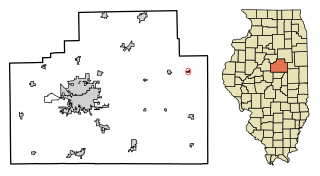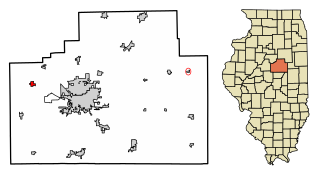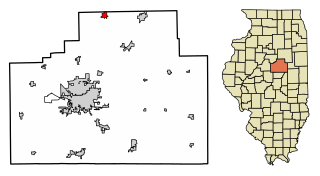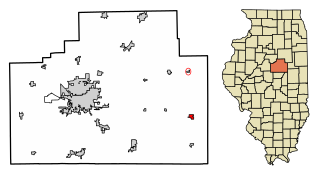
Dwight is a village located mainly in Livingston County, Illinois, with a small portion in Grundy County. The population was 4,032 at the 2020 census. Dwight contains an original stretch of U.S. Route 66, and from 1892 until 2016 continuously used a railroad station designed in 1891 by Henry Ives Cobb. Interstate 55 bypasses the village to the north and west.

Anchor is a village in McLean County, Illinois, United States. The population was 163 at the 2020 census. It is part of the Bloomington–Normal Metropolitan Statistical Area.

Arrowsmith is a village in McLean County, Illinois, United States. The population was 276 at the 2020 census. It is part of the Bloomington–Normal Metropolitan Statistical Area.

Bellflower is a village in McLean County, Illinois, United States. The population was 346 at the 2020 census. It is part of the Bloomington–Normal Metropolitan Statistical Area.

Carlock is a village in McLean County, Illinois, United States. The population was 548 at the 2020 census. It is part of the Bloomington–Normal Metropolitan Statistical Area.

Colfax is a village in McLean County, Illinois, United States. The population was 996 at the 2020 census. It is part of the Bloomington–Normal Metropolitan Statistical Area.

Cooksville is a village in McLean County, Illinois, United States. The population was 157 at the 2020 census. It is part of the Bloomington–Normal Metropolitan Statistical Area.

Danvers is a village in McLean County, Illinois, United States. The population was 1,089 as of the 2020 census. It is part of the Bloomington–Normal Metropolitan Statistical Area.

Ellsworth is a village in Dawson Township, McLean County, Illinois, United States. The population was 184 at the 2020 census. It is part of the Bloomington–Normal Metropolitan Statistical Area.

Gridley is a village in McLean County, Illinois, United States. The population was 1,456 at the 2020 census. It is part of the Bloomington–Normal Metropolitan Statistical Area.

Le Roy is a city in McLean County, Illinois, United States. The population was 3,512 at the 2020 census.

Lexington is a city in McLean County, Illinois, United States. The population was 2,090 at the 2020 census. There are two theories regarding the etymology of the city name. One says it was named for the Battle of Lexington, where General Gridley's father fought. and the other that it was named for the home town of James Brown, the town's co-founder.

McLean is a village in McLean County, Illinois, United States. The population was 743 at the 2020 census, down from 830 in 2010. It is part of the Bloomington–Normal Metropolitan Statistical Area. McLean is the home of the Dixie Travel Plaza.

Saybrook is a village in McLean County, Illinois, United States. The population was 654 at the 2020 census. It is part of the Bloomington–Normal Metropolitan Statistical Area.

Stanford is a village in McLean County, Illinois, United States. The population was 600 at the 2020 census. It is part of the Bloomington–Normal Metropolitan Statistical Area.

Jesse W. Fell was an American businessman and landowner. He was instrumental in the founding of Illinois State University as well as Normal, Pontiac, Clinton, Towanda, Dwight, DeWitt County and Livingston County in Central Illinois. He was also the founder of the newspaper The Pantagraph. As a close friend of Abraham Lincoln, it was Fell who urged him to challenge his opponent, Stephen A. Douglas, to their famous series of debates.
Shirley is an unincorporated community and census-designated place (CDP) in southwestern McLean County, Illinois, United States, just off Interstate 55. It was founded in 1854. As of the 2020 census, the population of the CDP was 135. Shirley is home to the Funk Prairie Home & Rock Museum.

Holder is an unincorporated community in Old Town Township, McLean County, Illinois.

Meadows, Illinois is a small unincorporated community located in McLean County. Meadows is located on US Route 24, midway between Chenoa and Gridley, with easy access from Interstate 55. Meadows at one time had a bank, general store, auto garage, a washing machine factory, and a school. All that remains in town is a nursing home, church, and a grain elevator. One railway line passes through the center of the town.
Sabina, also earlier known as Monarch, is an unincorporated community in West Township, McLean County, Illinois, United States.




















